|
香格纳上海西岸空间正在展出朱加个展《近期的绘画》,展览将于10月18日闭幕。 本文以艺术家的作品创作时间为线索进行梳理,回顾并介绍朱加早期创作历程中的部分重要作品。 |
作为中国录像艺术最早的实践者之一,他的作品在中国录像艺术史当中占据了独特的中心位置。1991年朱加在“新生代艺术展”中展出了现成品加工手绘作品《花布系列》,此后他开始更多的使用镜头语言进行艺术上的尝试,陆续创作了《大衣柜》、《谈话》、《永远》、《门》、《刻意的重复》等录像作品,以及《我的房间》和《他们俩有过性关系?》等等摄影作品,这些带有观念艺术倾向的讨论和实践,在当时对于媒介的实验性以及带有强烈的思辨色彩而备受瞩目。
As one of the earliest practitioners of video art in China, Zhu Jia's work occupies a unique and central position in the history of Chinese video art. In 1991, Zhu Jia exhibited his ready-made hand-painted work "Figured Cloth Series" at the "New Generation Art Exhibition", after which he began to experiment more with the language of the camera, creating video works such as "Wardrobe", "Talk", "Forever", "The Door" and "Repeat on Purpose", as well as photographic works like "My Room" and "Did They Have Sex?". At that time, these discussions and practices with a tendency towards conceptual art were notable for their experimentation with the medium and their strong ideological overtones.
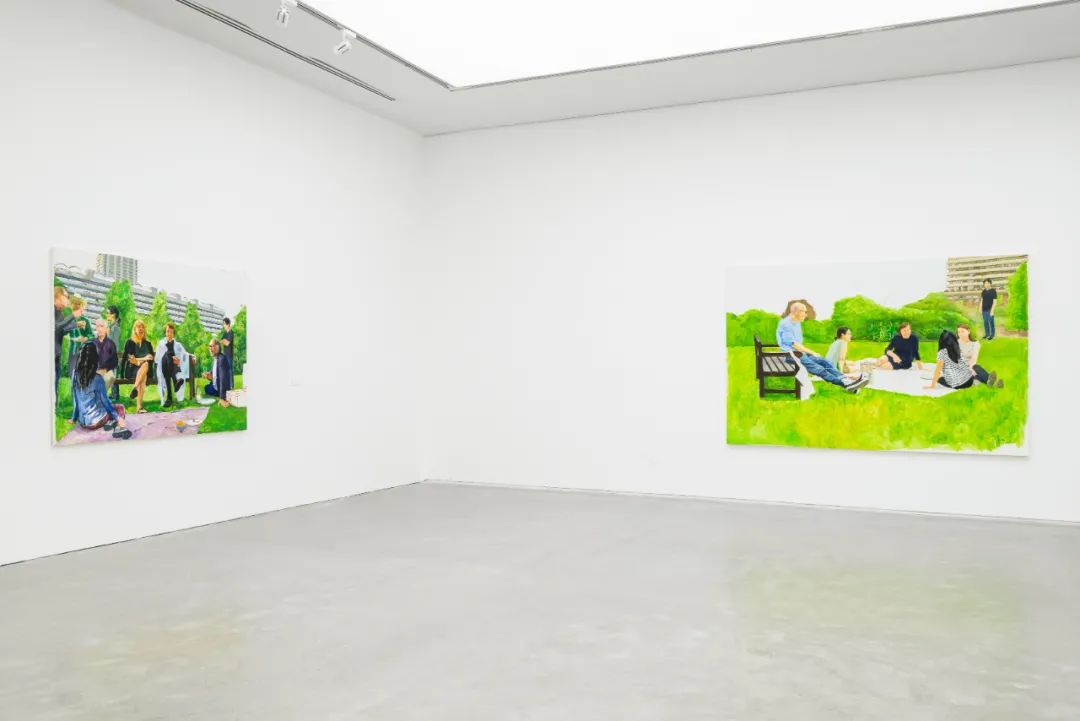
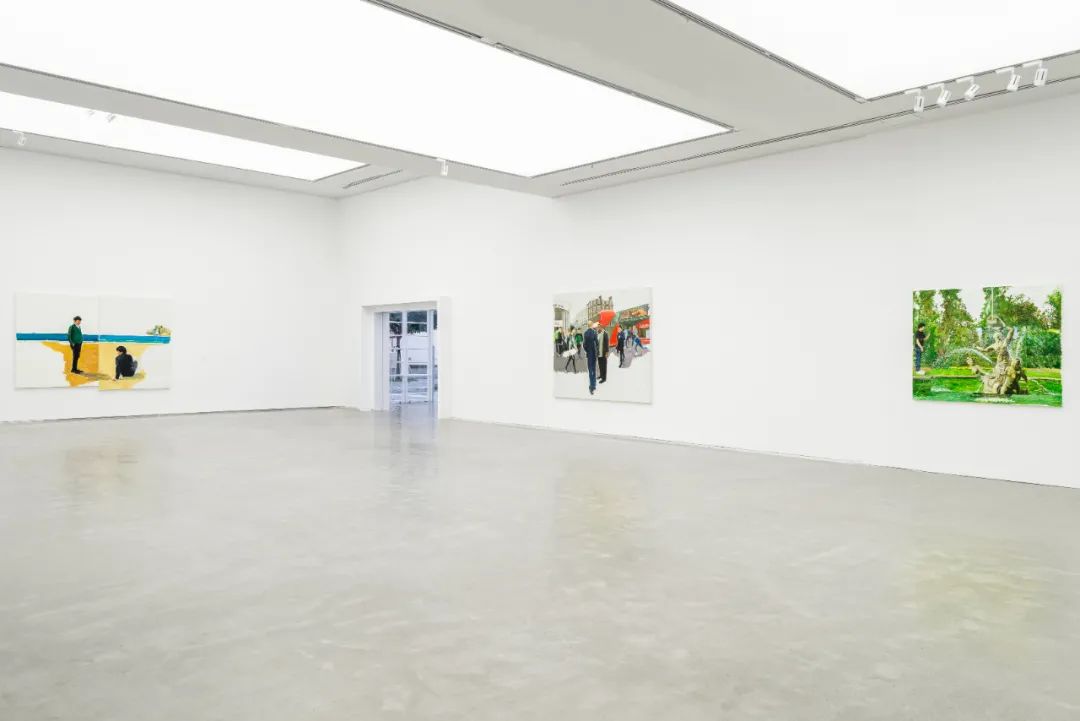
“朱加:近期的绘画”展览现场,香格纳上海,2020
Installation view of "Zhu Jia: Recent Paintings", ShanghART Shanghai, 2020
从中央美院附中到中央美术学院油画系的八年时间里,朱加接受了中国艺术院校内系统性的美术教育,同时与同龄人一样也受到上个世纪八十年代开放国门后被引进的西方文化的影响。用朱加自己的话说,他从来就不是一个循规蹈矩的“好学生”。1981年,朱加从美院附中一位年轻的老师得到了他的第一盘摇滚音乐录音带——“木匠兄妹”(也称卡彭特乐队 Carpenters,在一九八零年代风靡一时,著有《昨日重现》等经典歌曲),为今后在大学时期组建美院的摇滚乐队埋下伏笔。此外,朱加从当时能够阅读到的两种台湾艺术杂志《雄狮美术》和《艺术家》中收获了“稀有的、令人感到兴奋的信息”。在院校教育之外朱加广泛接触并吸收不同学科的养分,受到当时的引进文学和哲学等知识思想的启迪。
回想当时观看英国摇滚乐队的录影带和外国驻京使馆的电影录像带,朱加说,“图像中那些丰富的表达张力,以及放荡不羁的态度,对于我来说肯定有着潜移默化的作用,刚刚从学校出来,感觉到一种莫名的自由但也有过很多的虚无。做什么?怎么做?当然,其中还包含一些其它的因素和契机,使我拿起摄像机尝试着做点什么,你真的没法确定这就是件作品,当时没有人告诉你会有一个结果……”。
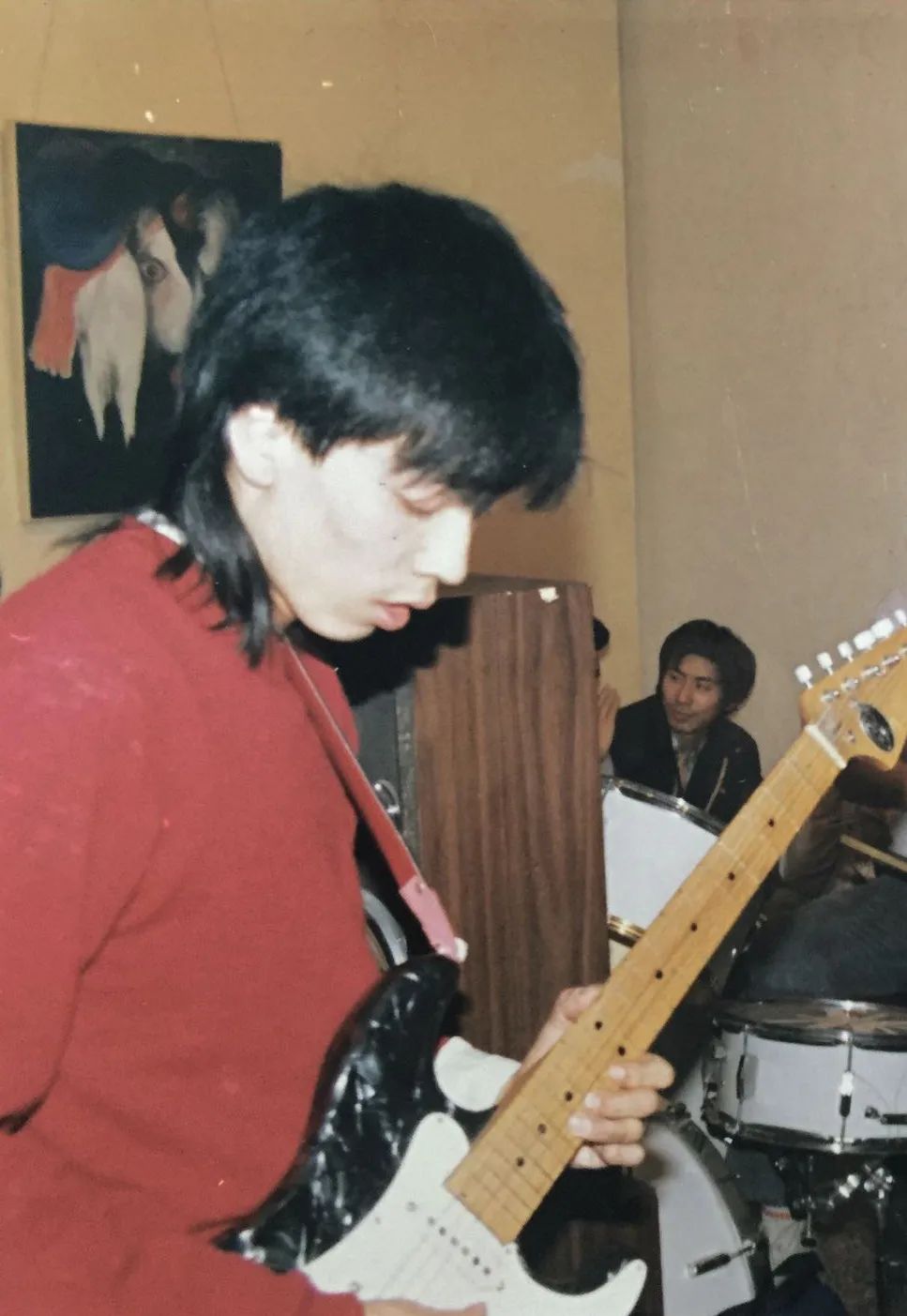
朱加在大学时期组建美院摇滚乐队
Zhu Jia formed a rock band at CAFA
During the eight years from the High School Affiliated to CAFA to the oil painting department of the Central Academy of Fine Arts, Zhu Jia received a systematic art education within the Chinese art academy, and was as influenced as his peers by the Western culture that was introduced in the 1980s when the country opened its doors. In his own words, he was never a "good student" who followed the rules. In 1981, Zhu received his first rock music tape, "The Carpenters"(a band that was popular in the 1980s, with hit songs like "Yesterday Once More"), from a young teacher at the High School Affiliated to CAFA, which paved the way for his formation of a rock band at CAFA during his college years. Also, Zhu Jia gained "rare and exciting information" from the two Taiwanese art magazines available at the time, Lion Art and Artist. Outside of his college education, Zhu Jia was exposed to and absorbed the nourishment of different disciplines, and was inspired by the introduction of intellectual ideas such as literature and philosophy.
Looking back at the time when he watched videos of British rock bands and films from foreign embassies in Beijing, Zhu Jia says, "The rich expressive tension in the images and the debauchery attitude had a subliminal effect on me. Just out of school, I felt some strange freedom but also a lot of emptiness. What to do? How does it work? Of course, there were other factors and opportunities that made me pick up the camera and try to do something. You can't really be sure that it's a piece of work, and there was no one there to tell you it was going to work out…"
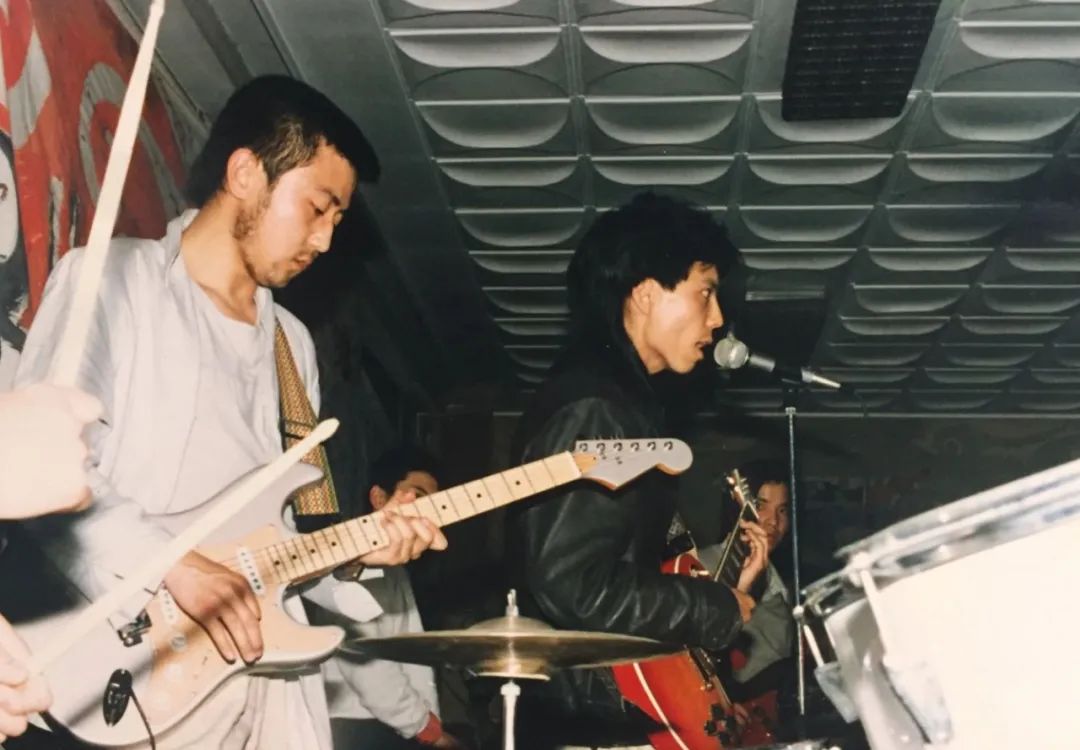
朱加在大学时期组建美院摇滚乐队
Zhu Jia formed a rock band at CAFA
相对于传统意义上按材料类别对作品进行分类,朱加更关注媒介本身的属性,关注媒介和作品观念的契合,探讨媒介作为创作工具带来的偶然性和必然性。朱加创作的第一件录像作品《大衣柜》(1992),是把摄像机当做身体的延伸,代替眼睛和手在衣柜中翻找的动作行为。艺术家在此强调的是摄影机自身的“深陷其中”,图像记录的是“媒介本身深陷其中”的过程,而非摄影机记录翻找衣柜的过程,通过赋予媒介的主观位置强调主观视觉的可能性。“这是逻辑的两个对应关系,看你把它放在哪个位置上”,朱加说到。
Compared to the traditional categorization of works according to materials, Zhu Jia is more concerned with the properties of the medium itself, and the fitness between the medium and the concept of the work, thus exploring the contingency and necessity brought by the medium as a creative tool. Zhu Jia's first video work, Wardrobe (1992), uses the camera as an extension of the body, replacing the hand and eyes as it moves inside a wardrobe. Here, the artist emphasizes the camera's own "immersion". The image records the process of "immersion of the medium itself", rather than the camera recording the process of searching through the wardrobe, emphasizing the possibility of subjective vision by giving the medium a subjective position. "It's a logical correspondence between the two, depending on where you put it", says Zhu Jia.
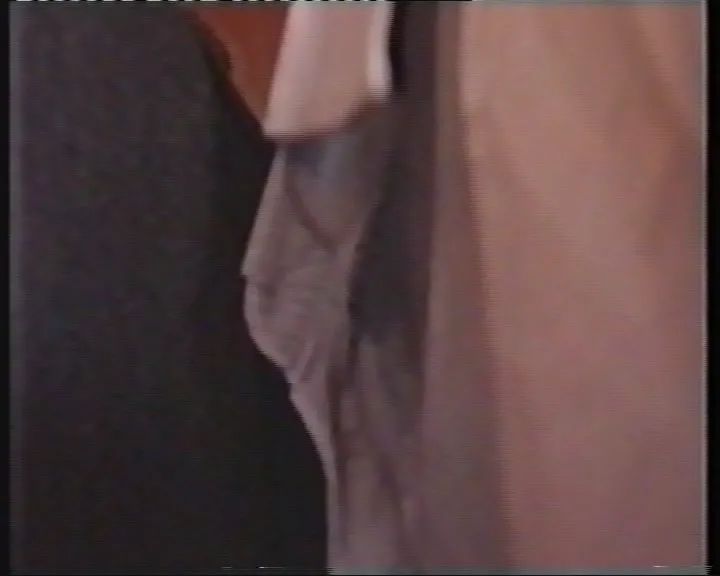
朱加 Zhu Jia | 大衣柜 Wardrobe | 单路视频 Single-channel video | 彩色,同期声 Colour, Actual sound | 7 minutes 30 seconds | 1992 | 截帧 Still
两年后,朱加创作了录像作品《永远》(1994)——一次对录像媒介的经典实验,艺术家最具代表性的作品之一。朱加将一台超8小型摄影机固定在三轮车左侧车轮的辐条上,镜头朝外,艺术家自己骑着三轮车在北京的街道上行驶了30分钟,摄影机记录下镜头随着车轮的转动运行轨迹而转动的图像。画面的内容是超出了常规的预判和想象,沿路拍摄的街景成为高速旋转的图形,偶尔可以分辨出一些具体的景物、行人、自行车和汽车,图像进入视野却又飞快消失,只有不断变化的状态是永恒的,“录像”的定义在这件作品中被解构。

朱加 Zhu Jia | 永远 Forever | 单路视频 Single-channel video | 27 minutes 16 seconds | 1994 | 截帧 Still
Two years later, Zhu Jia created the video Forever (1994), a classic experiment with the video medium and one of the artist's most iconic works. Zhu Jia fixed a high-8 video camera to the wheel of a tricycle on a self-made bracket. The lens oriented outward recorded city scenes as the artist rode the tricycle through Beijing streets for 30 minutes. The video imagery documented city scenes while simultaneously recording the movement of the tricycle wheel. The content of the images is beyond the conventional prediction and imagination, the street scenes along the road become rotating graphics at high speed. Occasionally, one can distinguish some specific scenery, pedestrians, bicycles, and cars. The images come into view but disappear quickly, only the state of constant change is eternal. The definition of "video" is deconstructed in this work.
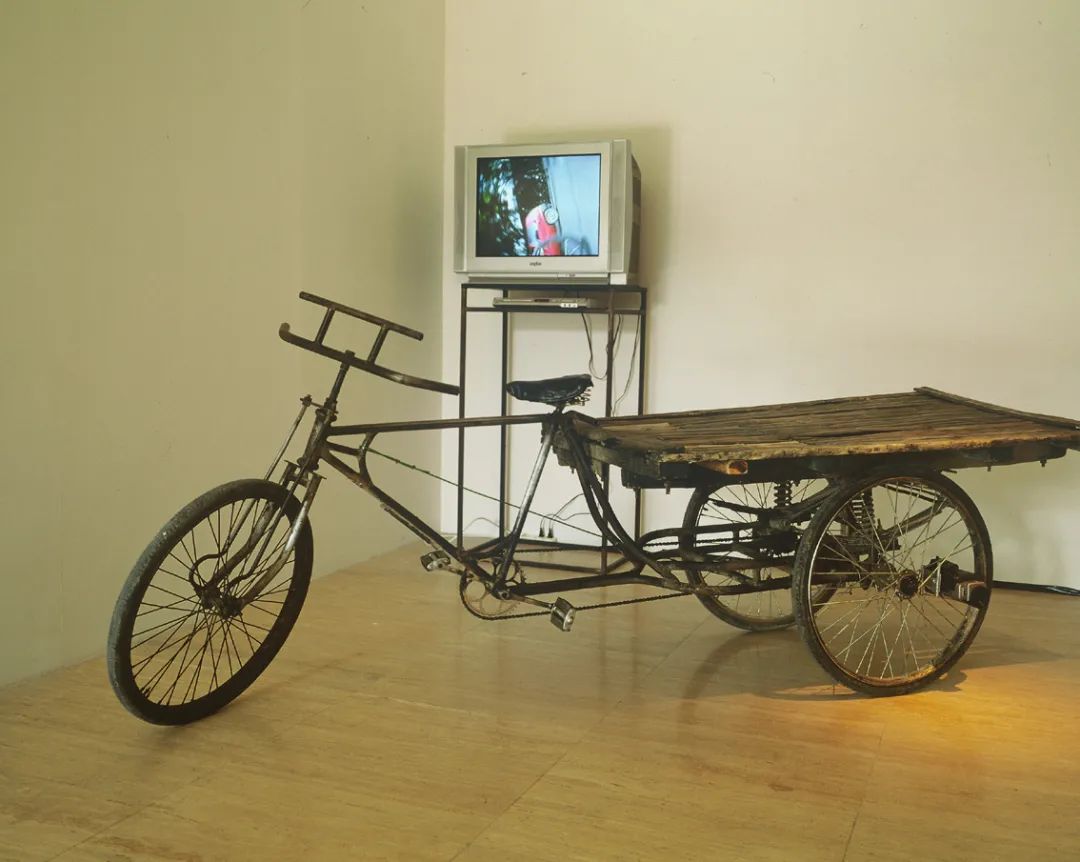
朱加 Zhu Jia | 永远 Forever | 单路视频;三轮车和录像机装置、电视机、DVD机 Single-channel video, tricycle and video camera sets, television, DVD | 录像 video 30 minutes | TV set 41.5*35*40cm | Tricycle 288*92*105cm | 1994《永远》在“聚焦:来自美国HAUDENSCHILD夫妇收藏的中国当代摄影和录像艺术展”,中国美术馆,北京,2003
Installation view of Forever at "Zooming into Focus: Contemporary Chinese Photography and Video from the Haudenschild Collection", National Art Museum of China, Beijing, 2003
上个世纪的90年代初期,随着中国的经济飞速的发展,社会的意识形态以及人文思想的割裂般的分裂和制衡,新的经验正在产生,包括商业消费和个体意识萌发,作者已经将公众事实重新演绎为私人想象力的领域。《我的空间》(1994)是朱加较早期的摄影作品之一,他自己充当“道具”,扮演面部浓妆、服饰呆板做作的男子(艺术家本人)。坐在家居样板间卧室的床上和客厅的沙发上,无处不在的展品标签提示着空间的商业本性。在刚刚出现具有市场经济商业模式的时代,很多中国人第一次直面消费主义的时刻,评论了消费社会对人的主观欲望的持续诱惑。艺术家敏锐地感受到这种商业模式的到来,势必会对于一个处在开放和转型期间的社会和价值观带来无法估量的转变,以追求精致时尚的现代社会的缩影——家居样板间暗示商业消费下的不安和尴尬。正如朱加当初给这件作品的副标题,一段阐述性的文字所言:现实环境在我内心深处造成的尴尬境界。

朱加 Zhu Jia | 我的空间 My Space | 彩色喷墨打印,无酸相纸 Colour inkjet print, Acid Free Paper | 120(H)*120(W)cm | 1994
In the early 1990s, with China's rapid economic development, the splitting fragmentation and checks and balances between the social ideology and humanistic thoughts, new experiences were emerging, including commercial consumption and individual consciousness. The artist had already reinterpreted public facts into the realm of private imagination. In My Space (1994), one of Zhu Jia's earlier photographic works, he acts as a "prop" himself, portraying a pretentious man with heavy facial makeup and stiff clothing, sitting on the bed in the bedroom and sofa in the living room of a domestic showroom, where the ubiquitous exhibit labels hint at the commercial nature of the space. In a time when the market economy business models had just emerged, many Chinese first confronted the moment of consumerism, commenting on the consumer society's continued seduction of human subjective desires. The artist is keenly aware that the advent of this business model will inevitably bring about an immeasurable shift in society and values during a period of openness and transition, and uses the epitome of modern society's pursuit of refinement and fashion – the home showroom – to suggest the uneasiness and awkwardness of commercial consumption. As Zhu Jia's original subtitle for this work, an expository text, stated: Reality creates a very awkward feeling, deep inside me.

《我的空间》在“朱加个展:临界的弥漫”,香格纳H空间,上海,2015
Installation view of My Space at "Zhu Jia: Critical Pervasion", ShanghART H-Space, Shanghai, 2015
事实上,朱加的摄影作品持续描绘了发生在社会空间里的意识和感知的连接。在摄影作品《他们俩有过性关系?》(1995)中,朱加将用印刷体打印出来一段文字“他们俩有过性关系?”的字牌举在公共开放的街道当中进行拍照,并且不断的变换角度和视角,热闹的街市和过往的行人在图像中与这个标牌形成了某些暗喻的巧合,以一种强制性的主观意念对在公共空间的个人私密进行了有效的干涉。在上个世纪九十年代中期,中国的公民意识刚刚处在主动萌发的情况下,艺术家敏锐的感受到变革中社会现实对个人权限的侵蚀,暗示语言和其所代表的社会定义对私人关系的权力制衡,挑战敏感话题下的大众心理。
Indeed, Zhu Jia's photographs continue to depict the connection of consciousness and perception that takes place in social spaces. In the photographic work Did They Have Sex? (1995), Zhu Jia printed out the text "Did they have sex?" in print, and photographed the placard in the middle of public open streets. With constantly changing angles and perspectives, the bustling market and passers-by formed a metaphorical coincidence with the sign in the image, effectively interfering with the privacy of the individual in the public space with an obligatory subjective idea. In the mid-1990s, when China's civic consciousness was just actively emerging, the artist was keenly aware of the erosion of individual privileges by the changing social reality, suggesting that language and the social definition it represented were checks and balances of power in private relationships, challenging the public psychology of sensitive topics.

朱加 Zhu Jia | 他们俩有过性关系?Did they have sex? | 爱普生艺术微喷 Epson UltraGiclee print | With white edge 70.5(H)*50(W)cm (x 8 pcs) | IMAGE 60.5*40cm | 1995
不同于常规录像和影视作品在时间线上展开叙事情节,朱加的早期作品基本上是在单一时间轴上的展开和重复,当然,这其中的原因是早期录像艺术家大都受到技术的限制和影响。“也正是因为如此,你会发现我在这其中找到了这种图像呈现方式的乐趣,标准的线性时间和叙事结构在我看来始终是和我没什么关系,或者说太正常了”。作品《门》(1996)中从屋内走出门外后关门锁门,两三秒钟之后开锁开门进屋,几秒钟后再次走出门外关门锁门,再次开锁开门进屋的匆忙的男子;录像作品《装订》(1996)中操作装订机器装订杂志的女工,这些单调重复的固定影像,看似流动,实则是一种循环往复的状态。影像的色彩基调灰暗,没有声音上的编辑,基本上是同期录音,更加强调了图像本身在作品中占有比例上的强大失衡,从而对观看者的“视觉心里经验”造成影响。

朱加 Zhu Jia | 门 The Door | 单路视频 Single-channel video | 黑白,同期声录音 B&W, Actual sound | 8 minutes 43 seconds | 1996 | 截帧 Still
Unlike conventional video and film work, which unfolds its narrative plot on a timeline, Zhu Jia's early works are basically unfolding and repetition of a single timeline, which is of course due to the technological limitations and influences that most early video artists were subjected to. "And because of that, you will find that I find pleasure in this way of presenting images, the standard linear time and narrative structure has always seemed to have little to do with me, or to be too normal". In The Door (1996), a hurried man walks out of the house, closes and locks the door, unlocks and opens the door two or three seconds later, walks out again a few seconds later, closes and locks the door, unlocks and opens the door again; and in the video work Binding (1996), a female worker is operating a binding machine to bind magazines. These monotonously repetitive fixed images appear to be in a state of flux, but are in fact cyclical. The grayish color palette of the images, the absence of sound editing (they are basically simultaneous recordings), further emphasize the powerful imbalance in the proportion of the images themselves within the work, and thus their impact on the viewer's "visual and mental experience”.

朱加 Zhu Jia | 装订 Binding | 单路视频 Single-channel video | 单通道彩色录像,同期声录音 Single Channel Colour Video, Actual sound | 7 minutes | 1996 | 截帧 Still
在这个线索下,那种对单一的片段进行反复乃至繁琐的堆砌,阻断常规的叙述发展而使时间无限延伸。1997年《与环境有关》中,一条金鱼在无水的状态下在一个原地蹦跳翻滚,没有情节变换和转折,影像将这个处在生命的临界点短暂时刻循环反复的使之没有尽头。2002年的《从不起飞》,影像的画面被限定在只是一架在跑道上滑行的波音飞机,伴随着发动机的鸣响,在跑道上滑行-滑行-滑行,其结果打破了观看者既有的期待。在这些影像中,感知的主观性几乎隐退,成为艺术家运用媒介的附属效应。

朱加 Zhu Jia | 与环境有关 Related to Environment | 单路视频 Single-channel video | 彩色,同期声 Colour, Actual sound | 19 minutes 15 seconds | 1997《与环境有关》在“每天:第11届悉尼双年展”,黄金岛旧船坞,悉尼,澳大利亚,1998
Installation view of Related to Environment at "Every Day: 11th Biennale of Sydney", Old Dock of Gold Island, Sydney, Australia, 1998
Taking this as a clue, the kind of repetitive and even tedious build-up of a single fragment blocks conventional narrative development and stretches time indefinitely. In 1997's "Related to Environment ", a goldfish jumps and tumbles in the same spot out of water, with no plot change or twist, the video repeats this brief moment at a critical point in its life, making it endless. In 2002's "Never Take Off", the image is confined to just a Boeing airplane taxiing – taxiing – taxiing on a runway with the sound of an engine, and the result defies the viewer's established expectations. In these videos, the subjective dimensions of perception emerge as almost a side-effect of the material manipulations of the medium.

朱加 Zhu Jia | 从不起飞 Never Take Off | 单路视频 Single-channel video | 黑白,后期音效制作 black and white, sound | 5 minutes | 2002 | 截帧 Still
迈入二十一世纪后,中国进入了经济高速发展的黄金时期,创造了瞩目的发展成就和经济神话,同时也出现了都市化进程的劳动就业和人口迁徙、教育和文化(学智和深度)缺失、生态环境等现状和议题。装置作品《烧心萝卜》(2005-2007)中大量使用过的廉价生活用品,并非按照现实的真实逻辑堆砌在展览现场,录影播放机里播放着艺术家实地拍摄的对外来务工者的采访,墙上贴满他在建筑工地和街道上捕捉的人物特写。通过现成物、图像、声音,朱加用大量细节再现了外来务工人员的生存状况,聚焦社会经济的贡献者——劳动务工人员,描绘繁荣表象下的个人肖像,引发观众对社会现实中的个体的关注。
As China enters the twenty-first century, it has entered a golden age of rapid economic development, creating remarkable achievements and economic miracles, as well as issues such as employment and migration of the laborers under the process of urbanization, lack of education and culture (in intelligence and depth), ecological environment, etc. In the installation Heartburn Radish (2005-2007), a large number of used cheap household items are piled up in the exhibition site according to a non- real logic of reality; the video player plays the artist's interviews with migrant workers, and the walls are covered with close-ups of people he has captured on construction sites and in the streets. Through readymade objects, images and sounds, Zhu Jia recreates the living conditions of migrant workers with a great deal of details, focusing on the social economy contributors – the laborers – and portraying individual portraits under the surface of prosperity, drawing the audience's attention to the individuals in social reality.
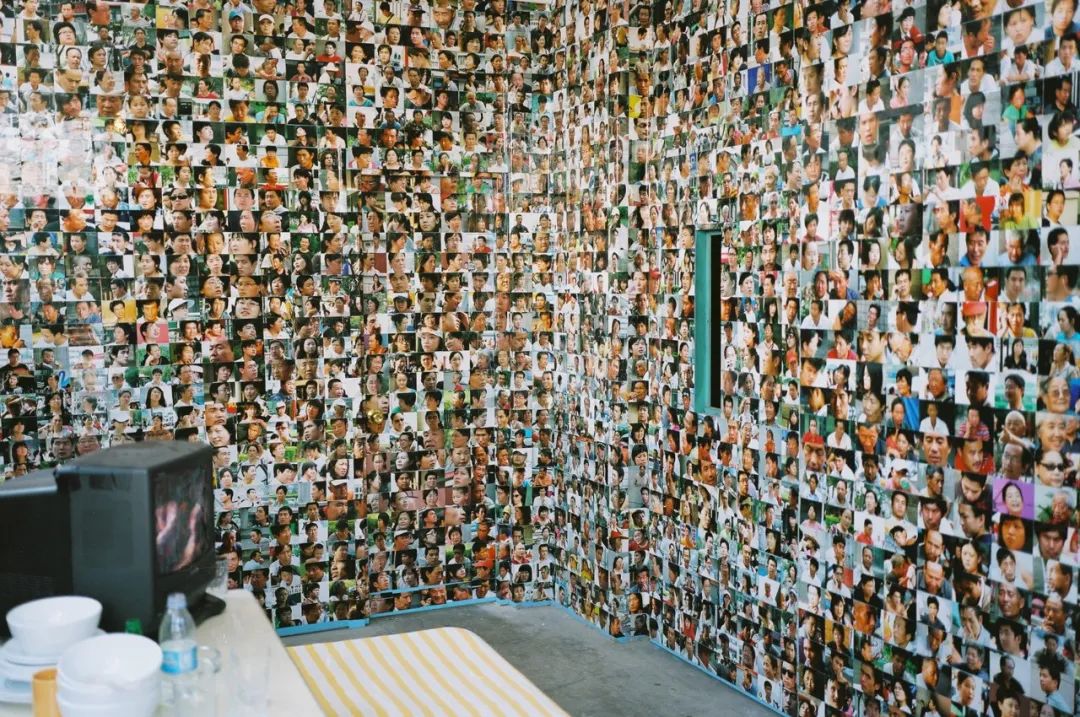
朱加 Zhu Jia | 烧心萝卜 Heartburn Radish | 综合材料 Mixed Media | 120 minutes | 2005 ~ 2007《 烧心萝卜》在“不仅是可能的,而且是必须的:第10届伊斯坦布尔”,伊斯坦布尔,土耳其,2007
Installation view of Heartburn Radish at "Not only Possible, But also Necessary: 10th International Istanbul Biennial", Istanbul, Turkey, 2007
朱在最近的录像作品中,融合了他早期的录像作品中对于物质的明显关注与对于摄影的主观关注,通过意识和感知显示了历史自身的过滤。和《双重风景》一样,它们使用了工作室制作影片的元素,配有服装,布景甚至一些对话。和早期作品一样,它们拒绝叙事。在《零》中,女主角在一系列不同的服装和场景中出现:海滩布景,历史建筑,工业发展的郊区。虽然片中的模特满怀期待地摆姿势和努力地与镜头沟通,但是摄影设备自身的出现不时打破充满幻觉的片刻,比如出现灯光或者移动摄影车,拉回镜子,卷上背景布。正如《从不起飞》中的飞机从未起飞,事物也从未结束。每次叙述将要开始时,场景就结束了。作品从朱的家族历史中获取元素,但是碎片拼接表明记忆的脆弱和进入历史的困难,即使这种过去是个人化的。

朱加 Zhu Jia | 双重风景 Double Landscape | 单路视频 Single-channel video | 16毫米胶片,彩色,无声 16mm film projection, color, no sound | 10 minutes | 2001 | 截帧 Still
In his most recent video work, Zhu merges the material concerns evident in his early videos with the subjective focus of his photography to show the filtering of history itself through consciousness and perception. Like Double Landscape, they employ elements of studio-produced feature films, with costumes, sets, and even some dialogue. And also like the earlier piece, they resist narrative. In Zero, the female protagonist is presented in a procession of different outfits and scenes: against a beach backdrop, around an historical apartment building, on the outskirts of an industrial development. And though she poses and looks out expectantly at the camera, the illusion of the moment is always broken by the intrusion the cinematic apparatus itself— the lights or the dollies is revealed, the mirror pulled back, the backdrop rolled away. Like the plane in Zhu’s earlier Never Take Off, things never quite take off. Each time the narrative seems about to begin, the scene comes undone. The piece draws on elements from Zhu’s family history, but the montage of fragments suggest the fragility of memory and the difficulty of accessing history, even when that past is personal.

朱加 Zhu Jia | 零 Zero | 彩色喷墨打印 Colour inkjet print | 110(H)*139(W)cm | 2012
同样,《华尔兹》(Waltz ,2013年)使用艺术家的家族历史来唤起中国过去的时光。一开始,我们看到一对舞者穿着毛时代的服装,在文革时期的音乐中起舞。录像的褪色感增加了怀旧情绪。一个模糊的人物靠近了舞者,怀疑这个时刻的真实性,对眼前的一切提出询问,但片中的舞者作了模糊性的回答。两人继续起舞。作品切换到另一场景,这是三十年代的中国。前一幕的男性舞者,穿着那个时期的典型服饰,自己跳着华尔兹。尽管独自一人,他仍十分专注。第三个人物再次出现,舞者否认这一幕的幻觉,坚持道:“想像!也是真实的!”但当他坐在一个化妆桌前,由化妆师陪伴时,布景开始拆卸。拍摄的结尾显示了想像力和表面性现实的无常,我们也得以见证了电影自身的元素。
Similarly, Waltz (2013) draws on the artist’s family history to evoke moments from China’s past. In the beginning, we see a couple dressed in Mao-era clothing dancing to a Cultural Revolution-era tune. The video’s faded palette heightens the sense of nostalgia. A blurry figure approaches the couple, casting doubt on the reality of the moment, only to be rebuked by the male dancer. The couple continues to dance. The piece then shifts to another scene, this time suggestive of China of the thirties. The male dancer from the previous scene is now waltzing by himself. Though he is alone, he continues just as raptly. Again, a third figure appears from off-screen, dispelling the illusion of the moment. Defying the intrusion, the man insists, “Imagination! It can be real, too!” And yet, as he sits down at a dressing table, attended by a makeup artist, the set begins to be taken apart. The shoot’s end signals the ephemerality of both imagination and seeming reality, and we are left to witness the elements of the filming itself.

朱加 Zhu Jia | 华尔兹 Waltz | 单路视频 Single-channel video | 单通道彩色高清电影,后期混音立体声音效 Single-Channel high-definition color film, stereo sound mixing | 10 minutes | 2014 | 截帧 Still
在拍摄《零》和《华尔兹》前,朱加创作了一件与过往不同的作品:既非录像也非摄影,事实上也他没有参与制作。《他人之像》(The Face of Facebook ,2011年)其实是一件集体作品,灵感源于朱恰好在《纽约客》杂志的封面上看到流行社交媒体创始人马克·扎克伯格(Mark Zuckerberg)的肖像(就像很多中国人,朱没有脸书账号)。他请一群艺术家朋友来阐释这幅肖像,最终形成一件共有67幅作品的群体署名的扎克伯格肖像。当然,这件作品也是一类自发生长的社交网络产物,因其包括了众多中国最知名的艺术家,也可被视为是一种真实的中国艺术景观的风景和视角。同样,从《我的空间》到《他人之像》,朱的作品从无数方式中,创作了一种今日中国社会的主观肖像和一种社会景观。
Just before making Zero and Waltz, Zhu Jia created a piece that stands out from his other work in that it is neither video nor photo-based, and in which in fact he had no hand in making. The Face of Facebook (2011) instead is a collective work that was inspired by a chance sighting of a portrait of Mark Zuckerberg, the founder of the popular social media service, on the cover of the New Yorker magazine. (Like many in China, Zhu does not have a Facebook account.) He asked a group of artist-friends to interpret the portrait, and the sixty-seven resulting contributions were combined into a single collective work, a group-authored portrait of Zuckerberg. Of course, insofar as the piece is also a homegrown social network of a sort, which in Zhu’s case happens to include many of China’s most prominent artists, it can also be considered also a kind of landscape, a view, of the Chinese art scene itself in its actuality. Likewise, in its myriad ways, Zhu’s work, My Space to the Face of Facebook, has produced a subjective portrait, a social landscape, of Chinese society today.

朱加 Zhu Jia | 他人之像 The Face of Facebook | 可变媒介 Variable media | 67件,可变尺寸 67 works, Variable sizes (mostly 30x30cm to 50x50cm) | 2011 ~ 2012
《他人之像》在“朱加 : 他人之像”,香格纳新加坡,2013
Installation view of The Face of Facebook at "ZHU JIA: The Face of Facebook", ShanghART Singapore, 1998
从2017年到2020年,朱加在频繁旅行和旅居期间创作了一系列“聚焦日常生活”的绘画。这一绘画系列,以平面绘画特有的定格画面和单一画幅的特质契合了他所追求的在自身范围对作品的掌控力和表达的观念。在每一幅画中,艺术家本人的形象以“在场者”的身份加入到画面中,展现与真实社交圈中艺术界人士的社交活动,从而形成一种常规之外的观看经验。
From 2017 to 2020, during his frequent travels and residencies, Zhu Jia created a series of paintings that "focus on everyday life". This series of paintings, with its freeze-frame and single-format quality, is in line with his quest for control and expression of works within his own scope. In each of the paintings, the artist's own image is added to the picture as an "attendee", showing the social activities of the art world in real social circles, thus creating an unconventional experience of viewing.
从录像作品、摄影作品,到近期的绘画作品,作品中呈现出的那种游离的质询和一种剥离过程当中的专注,反映出艺术家对于“常规经验”以外的经验的兴趣,更通过敏感的处理手段表达出艺术家个人的态度,这是一种与所谓的“社会景观”相对抗的一种经验,利用媒介自身的特质建立起图像与“自身的经验”隐隐约约的联系,将自身社会和现实的理解置入图像,转换图像本身的“原始含义”。
From video works, photography works, to recent paintings, the kind of wandering questioning and concentration in the process of detachment presented in the works reflect the artist's interest in experiences outside the "conventional experience". And moreover, they express the artist's personal attitude through sensitive processing means, which is an experience that opposes the so-called "social spectacles", using the qualities of the medium itself to establish an implicit connection between the image and "one's own experience", putting one's own understanding of society and reality into the image, and transforming the "original meaning" of the image itself.
©文章版权归属原创作者,如有侵权请后台联系删除